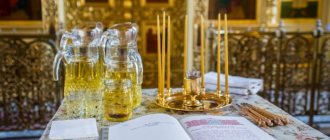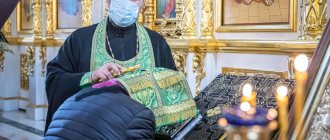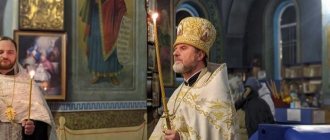ORTHODOX SACRAMENTS,
sacred rites established by divine providence, revealed in Orthodox church rites, through which invisible divine grace is communicated to believers. In Orthodoxy, there are seven sacraments, the seven gifts of the Holy Spirit: baptism, confirmation, Eucharist (comunion), repentance, the sacrament of the priesthood, the sacrament of marriage and the consecration of oil. Baptism, repentance and the Eucharist were established by Jesus Christ himself, as reported in the New Testament. Church tradition testifies to the divine origin of other sacraments.
Sacraments and rituals.
Also on topic:
RUSSIAN ORTHODOX CHURCH
External signs of the sacraments, i.e. Church rituals are necessary for humans, since human imperfect nature needs visible symbolic actions that help to feel the action of the invisible power of God. In addition to the sacraments, the Orthodox Church also accepts other liturgical rites, which, unlike the sacraments, are not of divine, but of ecclesiastical origin. The sacraments impart grace to the entire psychophysical nature of man and have a profound impact on his inner, spiritual life. Rituals call for blessing only on the outer side of earthly human life ( see
. SACRAMENTALS). The celebration of each sacrament carries with it a special gift of grace. In baptism, grace is given that cleanses from sin; in confirmation - grace that strengthens a person in spiritual life; Blessing of oil is a gift that heals illnesses; in repentance forgiveness of sins is given.
The knot that links heaven to earth
The Holy Fathers put a broad meaning into the word “sacrament”. In the first centuries of the Christian era, the Sacrament was everything connected with the saving mission of Jesus Christ: His Incarnation, Birth, Death on the Cross, Resurrection and other events of His life. The Church has always sought to show that the appearance of God in the world is a Mystery. It can partially open, while remaining covered, it can call to enter into itself, while remaining incomprehensible in its essence.
One of the expressions of this Mystery is the action of God’s grace in the heart of man, making him a participant in God. This is what we strive for when performing church ceremonies. Therefore, in a more private sense, the word sacrament means the sacred act itself, in which God invisibly influences a person with His grace.
The sacrament is the meeting point between God and man. This is the knot that connects heaven and earth. Man by himself cannot connect, unite heaven and earth. However, God gave this opportunity to man as a gift in the Person of the Son of God - Christ. Sending his disciples into the world, breathing on them, Christ said: “Receive the Holy Spirit. Whose sins you forgive, they will be forgiven; on whomever you leave it, it will remain on him” (John 20:22-23). The Earthly Church, in the person of the disciples of Christ, was given the power to “knit and loosen,” i.e. to do something that is effective in the otherworldly, Divine plane of existence.
Seven sacraments of the Orthodox Church
are designed to fill the seven most essential needs of a person’s spiritual life. The sacraments of baptism, confirmation, communion, repentance and consecration of oil are considered obligatory for all Christians. The sacrament of marriage and the sacrament of priesthood provide for freedom of choice. The sacraments are also divided into repeatable and non-repeatable during a person’s life. Only once in a lifetime are the sacraments of baptism and confirmation, as well as the sacrament of the priesthood, performed. The remaining sacraments are repeatable.
Order of those united from other faiths to the Orthodox Catholic Eastern Church
The book contains rites for the reception of non-Christians and Christians of other confessions into the Orthodox Church:
a) through the Sacrament of Baptism (pagans, Jews, Mohammedans);
b) through the Sacrament of Confirmation (Lutherans, unconfirmed Catholics and Calvinists); c) through the Sacrament of Repentance (those who were baptized and anointed, but fell away from the Orthodox Church and fell into schism).
The book is an extract from the Great Trebnik of some chapters (97, 98, 103–106) with several additional articles. The order of rites was published as a separate book in 1757
year and then republished in 1845 and 1858.
Baptism
- the very first of the Christian sacraments, it marks the entry of the believer into the Church of Christ. Its establishment was preceded, according to the Gospels, by the baptism (purifying immersion in water) of Jesus himself in the Jordan, performed by John the Baptist. Christian baptism as a sacrament began with the words of Jesus addressed to the apostles before his ascension into heaven: “...go and make disciples of all nations, baptizing them in the name of the Father and the Son and the Holy Spirit” (Matthew 28:19; Mark 16:16). Methods of baptism in the ancient church are described in the Teachings of the Twelve Apostles
(1st – beginning of 2nd centuries): “Baptize alive [i.e. running] water in the name of the Father and the Son and the Holy Spirit. If there is no living water, baptize in other water; If you can’t do it cold, then warm it. And if there is neither one nor the other, then place it on your head three times.” Water as a cosmic and sacred element plays a crucial role in the performance of the sacrament: baptism is performed through three times immersion in water with the pronouncement of the formula “In the name of the Father and the Son and the Holy Spirit.” Divine grace acting through the water element frees a person from all sin: infants - from the firstborn, adults - both from the original, and from those committed during life. The Apostle Paul called baptism the washing of regeneration.
In post-apostolic times, infant baptism was already accepted. Adults prepared to receive the sacrament through catechism (catechesis). The catechumen usually lasted two years, during which the most important part of Christian teaching was communicated to the catechumens. Before Easter, they added their names to the list of those being baptized. The solemn baptism of a large number of believers was performed by the bishop. During the times of persecution of Christians, natural reservoirs, rivers and streams served as places of baptism. Since the time of Constantine the Great, baptism took place in baptisteries, specially constructed pools at churches ( see
. BAPTISTERY). Immediately after immersion, the presbyter anointed the forehead of the person being baptized with oil (olive oil), after which he was clothed in white robes, a symbol of his acquired purity and righteousness. After baptism, the Holy Mysteries were received in the church. The seriously ill and those in prison were baptized through pouring or sprinkling.
The traditions of the ancient church are preserved in Orthodoxy today. Baptism takes place in the temple (in special cases it is allowed to perform the ceremony in the house). Adults are baptized after instruction in the faith (catechumen). The announcement is also made at the baptism of infants, and the recipients act as guarantors for their faith. The priest places the person being baptized facing east and says prayers that drive away the devil. Turning to the west, the catechumen renounces Satan and all his works. After renunciation, he again faces the east and three times expresses the desire to unite with Christ, after which he kneels. The priest censes the font with three lit candles, hands the candles to the recipients and blesses the water. After the blessing of the water, the oil is blessed. The sign of the cross is made with oil over the water, as a symbol of reconciliation with God. Then the priest draws the sign of the cross on the forehead, ears, arms, legs, chest and shoulders of the person being baptized and immerses him three times in the font. After the font, the baptized person dresses in white clothes, which are usually preserved throughout life as a relic. In case of mortal danger, the ritual is performed in a reduced order. If there is a danger of the baby's death, baptism is allowed to be performed by a layman. In this case, it consists of immersing the baby in water three times with the words “The servant of God is baptized in the name of the Father Amen, and the Son Amen, and the Holy Spirit Amen.” The baby's name is left to his parents to choose, while adults choose it for themselves. If such a right is granted to a priest, he is obliged to choose the name of the saint closest in time to the celebration after the birthday of the person being baptized. Cm.
BAPTISM.
Why is it necessary to take part in the sacraments?
A church sacrament is a special action that guarantees a person grace from higher powers. Quite often, to ask for healing or well-being for our loved ones, we come to the temple and take part in the service. It is also quite common in Orthodoxy to hand over notes with names to clergy who pray for the people indicated on the paper. But all this may be effective, or it may not. Everything depends on the will of God and his plans for you.
But church sacraments in Orthodoxy make it possible to receive grace as a gift. If the sacrament itself is carried out correctly and a person is determined to receive a blessing from God, then he falls under the influence of the grace of the Holy Spirit, and it is up to him how to use this gift.
Confirmation.
According to the canons (rules) of the Orthodox Church, immediately after baptism a Christian receives the sacrament of confirmation. In this sacrament, believers receive the gifts of the Holy Spirit, giving them the strength to be firm in the Orthodox faith and maintain the purity of their souls. The right to perform confirmation belongs only to bishops and priests. Separately from baptism, it is performed during the anointing of kings as kings, as well as in cases when non-Christians who were baptized according to a rite corresponding to the rules of the Orthodox Church, but were not anointed, join Orthodoxy. Confirmation after baptism occurs as follows. After dressing the baptized person in white robes, the priest says a prayer in which he asks God to grant the new member of the church the seal of the gift of the Holy Spirit, and applies the signs of the cross with chrism on his forehead, eyes, nostrils, ears, chest, arms and legs. Then the presbyter and the newly baptized together walk around the font three times with candles in their hands while singing the verse: “As many as were baptized into Christ, put on Christ.” This ritual symbolizes the baptized person's entry into eternal union with Christ. This is followed by the reading of the Apostle and the Gospel, after which the so-called. ablution. Having soaked his lip in warm water, the priest wipes the places that were anointed with myrrh, with the words: “You were baptized, you were enlightened, you were anointed with myrrh...” The anointing performed during the crowning of kings is neither a special sacrament nor a repetition of what was previously done. The sacred anointing of a sovereign means only a higher degree of communication of the gifts of the Holy Spirit necessary for him to fulfill the ministry to which he is called by God. The ritual of the coronation and anointing of the king is a solemn act, completed by the introduction of the sovereign to the altar, where at the throne he takes communion as the anointed of God, the patron and protector of the church. Cm.
CONFIRMATION.
"Today the prince of this world will be cast out..."
The world in which the Gospel message was first heard was not an irreligious world. On the contrary, it was a world with its own culture of religious rites and ceremonies. They didn't just vibrate the air, they actually penetrated the world of spirits.
What spirits? Light or evil?
More likely the second. The expression “Satan is the prince of this world” (John 12:31) is not just a nice turn of phrase.
And the word of the Gospel that sounded two thousand years ago was not about a new philosophical teaching, but about a new religious experience. Speaking about the incomprehensibility and other nature of God, Christianity gave man the opportunity to participate in the Divine Life. The Church opposed the pagan mysteries with its mystical life. The Church contrasted the experience of communication with fallen spirits with the experience of communication with the Lord. Actually, the entire Christian life is the constant Sacrament of communication with God and neighbors.
When Christ, bidding farewell to his disciples, says: I am with you throughout all of this, to the end of the age, this must be understood in the most literal sense. The Savior is with us, even if invisibly. He shares our life with us: both joy and sorrow.
Our entire religious life is built on the fact that we are united with God. This connection is established in the Sacraments, supported by rituals, prayer and the entire structure of spiritual life.
Repentance.
This sacrament cleanses the believer from the sins he committed after baptism and gives strength to continue the feat of earthly Christian life. By confessing his sins to a priest, a Christian receives forgiveness from him and is mysteriously absolved from his sins by God himself. Only a bishop or priest can accept confession, since they receive the right to forgive sins through the sacrament of the priesthood from Jesus Christ himself. The priest is obliged to keep the secret of confession; For publicizing the sins confessed to him, he is deprived of his rank. The Gospel teaching understands repentance not simply as repentance for what has been done, but as rebirth, renewal of the human soul. The sacrament of repentance is performed as follows. In front of the icon of Jesus Christ or in front of the Holy Cross, the priest reads prayers for the penitents for everyone who comes to the temple for confession. The very confession of sins to the priest occurs alone with him. The penitent lists his sins, and when he finishes, he bows to the ground. The priest, having placed the epitrachelion on the head of the confessor, reads a prayer in which he asks for his forgiveness, makes the sign of the cross over his head, and then lets him kiss the cross. In special cases, the priest has the right to impose penance, i.e. a certain kind of punishment in accordance with the severity of the sin. There is a rule in the Orthodox Church that every Christian must go to confession at least once a year. see also
CONFESSION; REPENTANCE.
Sacrament is an act of absolute freedom
However, the Sacrament presupposes the conscious movement of the human soul towards God. A meeting with God is always an act of absolute human freedom and its highest manifestation. God can only speak to man face to face; He does not need any intermediaries. Therefore, a forced Sacrament, even in the most subtle sense, is impossible.
Today, of course, no one will force anyone to accept the Sacrament. However, some simple-minded people, observing with bitterness that their children or grandchildren are moving away from the Church, try to somehow attract attention to the temple with promises of gifts or threats of God's punishment.
As a result, people who are far from true faith and Christian life become participants in the Sacrament. And, approaching the Sacrament, they expect from it not at all what they should expect. The result is exactly the opposite of what they are trying to achieve. A person who approaches the Sacrament without trust and even the slightest humility will not feel anything and may lose even those grains of faith that he possessed.
Communion or Eucharist
(Greek “thanksgiving”) is the main Christian sacrament. In the final part of the liturgy, bread and wine are transformed into the true Body and Blood of Christ and are presented for consumption by the faithful for the sanctification of soul and body. By accepting the Holy Gifts, a Christian mysteriously unites with Christ himself and becomes a participant in the cosmic church. The Orthodox Church communes believers with the Holy Mysteries under two forms - bread and wine. The priest brings the Holy Gifts in a bowl from the altar, the believers approach him, folding their hands crosswise on their chests as a sign of reverence, and call their name received in baptism. The priest, with the help of a spoon, gives each person a piece of the Body and Blood of Christ (transubstantiated bread and wine). The deacon helping him wipes the lips of the communicant with a cloth. The person receiving communion kisses the chalice and, in the vestibule of the church, drinks the so-called communion. warmth (wine diluted with warm water). In remembrance of the fraternal meals of apostolic times, particles of prosphora are distributed to all communicants. At the end of the service, those receiving communion are required to read or listen to the prayers of thanksgiving read in the church. The Church admits to communion only those believers who have properly prepared themselves through fasting and repentance. A special type of celebration of the sacrament of the Eucharist is the communion of the sick who, due to serious illness, cannot attend the liturgy in church. In such cases, the church sends the sacrament to the home, leaving for the sick part of the Holy Gifts prepared at the liturgy. see also
EUCHARIST; LITURGY; MASS.
The Eucharist is the most important value of the Church
We often hear the phrase “traditional values”. Basically, it is the disclosure of this formulation that is the content of our sermon addressed to the world; a world in which obvious things become less and less obvious. While preserving the content of our external testimony in this way, within ourselves, in the church circle, we should more often pose the question of what determines the range of these traditional values, or rather, what, in our understanding, fills these values with their own value content. And we will never be mistaken if we say that this value basis, the basis of our confession and worldview, the source of inspiration and conviction is the Eucharist. And this is because, according to the faith of the Church, it is in the Eucharist that she meets Christ, unites with Him, draws strength and knowledge, communicates with him and intimately experiences the meeting of the earthly and the heavenly: the meeting with the Source of full life and lasting meaning.
The Eucharist is the true value of the Church, because it unites us with Christ, without whom the Church is not the Church. The Eucharist gives the Church an existential and semantic basis, making it a unique divine-human community. That is why the Church, its life and activity are a unique phenomenon, without which the life of the world would have no meaning or justification. Christ founded the Church for this purpose, so that it would live by it and communicate it to the world. This is the clear goal and at the same time the foundation of the Church: to give the world Christ, the living God incarnate.
This principle of existence – the Eucharistic existence of the Church – was laid down by Christ Himself. The Eucharist appeared at the dawn of the history of the Church, even before the saving suffering, death and resurrection of Christ. It was the core of the emerging community of believers before any sacred text and before any established tradition. The Eucharist updated the experience of the apostles and those who were close to Christ, who listened to Him and lived with Him. This experience would not differ from the experience of the followers of other eminent teachers and prophets, from the experience of other communities, if it did not find its highest expression in the Eucharist.
At the beginning of the Gospel of Luke, where the birth of the Savior is narrated, the angel of the Lord announces to the Bethlehem shepherds “great joy that will be to all people” (Luke 2:10). Concluding the “Good News,” the evangelist Luke writes about the apostles: “They worshiped Him and returned to Jerusalem with great joy...” (Luke 24:52). The joy of a person who has found God cannot be analyzed or defined; one can only enter into it - “enter into the joy of your Master” (Matthew 25:21). And we have no other means of entering into this joy other than that sacred act, which from the very beginning of the Church has been for her both the source and the fulfillment of joy, one might even say, the very sacrament of joy. The sacred rite is the Divine Liturgy, at which the “mystery of the sacraments” is celebrated - the Holy Eucharist.
We advise you to study Prayers to Spyridon of Trimifuntsky for health
Sacrament of the Priesthood.
All sacraments, with the exception of baptism, can be performed only in a legal manner (i.e., in accordance with the canons of the Orthodox Church) by an ordained priest, since upon ordination he receives this right through the sacrament of the priesthood. The sacrament of the priesthood consists in the fact that through the laying on of a hierarch (ordination) the Holy Spirit descends on the one appointed to a hierarchical degree. The grace of the Holy Spirit invests the initiate with special spiritual power in relation to believers, gives him the right to lead the flock, instruct them in the faith and improvement of spiritual life, and also perform church sacraments for them. The degrees of priesthood are as follows: deacon, priest (presbyter) and bishop. Other persons of the clergy, the so-called. clergy are consecrated not through ordination, but only with the blessing of the bishop. One is initiated into the highest degrees of the hierarchy only after successively passing through the lower ones. The method of ordination to one or another degree of priesthood is indicated in the instructions of the apostles, in the testimonies of the church fathers and in the rules of ecumenical councils. Grace is not given to each degree in equal measure: less to the deacon, more to the presbyter, and more to the bishop. According to this grace, the deacon performs the role of a co-celebrant of the bishop and presbyter during the celebration of the sacraments and divine services. The presbyter, through ordination from the bishop, receives the right to perform all sacraments, except the sacrament of the priesthood, and all divine services in his parish. The bishop is the main teacher and first clergyman, the main manager of the affairs of the church in his diocese. Only a council of bishops numbering at least two can ordain bishops. The sacrament of the priesthood is performed at the altar of the church during the liturgy, so that the newly ordained person can take part with the entire clergy in the consecration of the Holy Gifts. At the liturgy, ordination is performed on only one bishop, one presbyter and one deacon. The one ordained as a deacon is brought to the royal doors, where he is met by deacons who lead him into the altar. At the altar, he bows to the throne, walks around it three times and kisses the corners of the throne, as if taking an oath to reverently honor the holiness of the altar and throne. As a sign of humility before the bishop ordaining him, after each round he kisses the hand and knee of the bishop, then bows three times to the throne and kneels on one right knee, since the deacon is entrusted with partial priestly service. To commemorate the fact that he devotes all the strength of his soul to serving at the throne, he places his hands on the throne and places his forehead against it. Initiation is preceded by certification that not only the person being initiated, but also all members of his family are Orthodox Christians. The Orthodox Church adheres to the rule of not repeating ordination if it was performed correctly, even in non-Orthodox societies. see also
DEACON; BISHOP; CHURCH HIERARCHY; CLERGY; PRESBYTER; PRIEST.
That is why many of you are weak and sick, and many are dying.
There are gestures that express greater depth of human relationships. This includes a kiss, a handshake, and any manifestation of affection and tenderness from one person to another. But if we deprive them of spiritual content, true feeling and turn them simply into body movements, they will become at best funny, and most likely disgusting.
And just as when we carelessly handle an ordinary-looking hose, we risk receiving an unexpected electric shock if it turns out to be an electrical cable, the same is the case with the Sacraments.
The Church says that you can accept grace even in condemnation. About this are the strict words of the Apostle Paul about the Eucharist, spoken to his contemporaries: “Let man examine himself, and in this way let him eat of this bread and drink from this cup. For whoever eats and drinks unworthily eats and drinks condemnation for himself, without considering the Body of the Lord. This is why many of you are weak and sick, and many are dying” (1 Cor. 11:27-30). Eating and drinking unworthily means approaching the Sacrament without realizing the truly cosmic scale of the spiritual side of the events in which a person takes part.
“The Eucharist is called a Sacrament,” wrote St. John Chrysostom, “for what we believe is different from what we see, for we see one thing and believe in another... When I hear a mention of the Body of Christ, I understand what is said in one sense, and an unbeliever in another.” .
A disdainful attitude towards the Sacrament, towards the grace of God, is always associated with some inferiority, insensibility or perversion of spiritual life. Usually a person seeks to somehow justify his inferiority, based on the principle that the best method of defense is attack. This is called blasphemy. It is always very dangerous and can cause irreparable harm to a person.
That is why the ancient Christians (not out of any harmfulness and greed, but out of pity and caution) did not allow unbelievers and unbaptized people to attend Eucharistic meetings and participate in other Sacraments. For such people, the most important, spiritual component of the Sacrament is hidden. An event of great spiritual power may turn out to be reduced for them to the level of a colorful theatrical action or, even worse, an unpleasant or funny show.
Sacrament of marriage
- a sacrament performed over the bride and groom, believers who have chosen the path of married life, during which they give a free promise to the priest and the church to remain faithful to each other, and the priest blesses their union and asks them for the grace of pure unanimity for the birth and Christian upbringing of children. Marriage is an image of the union of Christ and the church. Before commencing the sacrament of marriage in the church after the liturgy, an announcement takes place, that is, the clergyman tells the parishioners the names of the bride and groom and asks if they know of any obstacles to the conclusion of this marriage. After the announcement, the marriage itself takes place. The sacrament of marriage always takes place in the temple in the presence of witnesses. The ceremony is performed by a priest. The ceremony of marriage consists of two parts: betrothal and wedding. For the betrothal, the priest leaves the altar and places a cross and the Gospel, symbols of the invisible presence of Christ himself, on a lectern in the middle of the temple. He blesses the bride and groom and gives them lighted candles, which signify their purity. After reading certain prayers, the rings consecrated on the throne are brought, and those entering into marriage put the rings on each other as a sign of mutual consent. During the wedding, the marriage union is blessed and the descent of divine grace upon it is requested. At the end of the prayers, the priest takes the crowns and places them on the heads of the bride and groom. The crowns signify a reward for their chaste life before marriage. After the death of one of the spouses, marriage can be performed a second or third time. The celebration of the sacrament of a second or third marriage is not so solemn. Those who are bigamous or triple-wedded are not given candles or crowns placed on their heads. Remarriages are allowed by the church after penance has been carried out.
Greetings to the young
I am very happy, being with you today, to realize that before me are Orthodox youth, that is, those youth about whom it can no longer be said that they are only on the threshold of the Church.
You are a truly new generation of church-going young people - those who, like all young people of all times, are looking for meaning, truth, God, looking for their path in life, but, unlike many people of my generation, they know where to look, and firmly connect the formation of their inner man with the Church. Today, in many ways, it is you who shape and renew the Body of Christ, His Church. You are hope not only for the Church, but also for our entire society. You live among the world, being in its most dynamic segment. You are where there is a struggle between good and evil, where it is not yet clear who the winner is, but a lot depends on what is at the core of your life.
We advise you to study Prayers to Sergius of Radonezh for successfully passing the exam
Nowadays, it can no longer be said that the Russian Orthodox Church is only a resurgent Church. The initial stage of church revival has ended. Today the Church is called to live not so much a new romantic impulse, but rather the full-blooded life of a mature organism - with its own internal way of life, a clear position. And we must understand what makes us unique, and what is truly exceptional about us among the many modern communities and subcultures.
Can we simply say that we are the guardians of some abstract truth or truth? That we are Orthodox and that is the only reason why God is with us? What have we preserved, or rather, has someone preserved some unspoiled tradition for us? Are we just representatives of a certain subculture or are we the “salt of the earth” and the “light of the world”? What does our hope of salvation mean? What does this word even mean - “salvation”, which has long been no longer thought of in modern society as our ancestors understood it?
Among our Orthodox youth, all these questions arise in one form or another and force young hearts and minds to take a fresh look at the content of our faith. They are directly or indirectly present in discussions and conversations in theological schools, in youth groups in parishes, encouraging a young person to build for himself a certain scale of priorities: what is the foundation of my faith, and what is based on this foundation?
Answering these questions is all the more important because a young man often faces a choice on the correctness of which his entire subsequent life depends. It is at a young age that, as a rule, the choice occurs between monasticism or family life, between priesthood or serving the Church in the lay rank
All these significant and defining steps cannot be spontaneous actions, but must become decisions of a person who has specific goals determined by clear values for himself.
Blessing of oil, or unction.
In this sacrament, when anointing with oil, the sick are given grace that heals mental and physical infirmities. Anointing is performed only on the sick. It is prohibited to perform it on the healthy, as well as on the dead. Before the consecration of oil, the sick person confesses, and after (or before) receives communion. The performance of the sacrament involves a “gathering of believers,” although it can take place both in church and at home. A council of seven presbyters according to the number of gifts of the Holy Spirit is also desirable, but the presence of two or three priests is also allowed. In extreme cases, one priest is allowed to act, but say prayers on behalf of the cathedral. To perform the sacrament, a table is set up, and on it is a dish with wheat. Wheat grains serve as a symbol of rebirth to new life. A vessel with oil, a visible sign of grace, is placed on top of the wheat. Wine is poured into it: combining oil with wine is done in memory of the fact that this is exactly what the Evangelical Good Samaritan did to treat the sick. Anointing brushes are placed nearby and seven candles are lit. The service of the sacrament consists of three parts. The first part is prayer singing. The second part is the blessing of oil. The first priest reads a prayer for the consecration of the oil, the rest repeat it quietly, then sing troparia to the Mother of God, Christ and the holy healers. The third part consists of seven readings of the Apostle, seven readings of the Gospel and seven anointings. Those parts of the body through which sin enters a person are anointed: forehead, nostrils, cheeks, lips and both sides of the hands. After the seventh anointing, the priest places the open Gospel on the head of the sick person, which signifies the hand of the Savior himself, healing the sick. see also
PREPRESENTATION; SECRET.
God's Territory
And lastly: The Sacrament is a gesture of the Lord’s great love for us. After all, the Sacrament is not abstract religious reflections, not elusive prayers. During the Sacrament, the material substance of our world is sanctified and becomes a participant in the grace of God. And this world is no longer alien, not evil, Satan has not completely privatized it. There is also the territory of God in this world - things and objects that come into contact with us and contain the fire of grace. In this territory, here on earth, the Kingdom of God is anticipated and revealed to us. And Christ Himself gave it the name - this is the Church that lives in the Sacraments.










